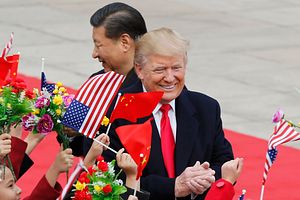While the economic and military dimensions of U.S.-China relations continue to receive the lion’s share of public attention, the role of “soft power” in the relationship between Washington and Beijing should not be underestimated. Although the United States has always maintained its supremacy as a globalization pioneer, China is rapidly intensifying its soft power potential and promises to leave no stone unturned in glorifying its international appeal. The question, however, remains whether China’s impassioned soft power strategy radically challenges the United States’ international position, especially in light of the latter receding from its globalist role, or if the concept will potentially kindle a sense of mutual understanding toward a reshaping of the global order.
Road to Soft Power: China vs. the United States
Soft power, a term first introduced by Harvard’s Joseph S. Nye Jr., is largely defined as the ability to shape other’s preferences. Since its inception, the concept quickly became recognized as an indispensable component of public diplomacy and strategic communications. The United States was one of the first countries to acknowledge the essence of soft power and utilize it to amplify its global influence, particularly via the Marshall Plan that earned immense international accolade. Over the decades, the United States has successfully tapped all sociocultural mediums, including its prestigious Ivy League education system and its rich multimedia portfolio, in establishing a sweeping universal appeal. American companies such as Facebook, Amazon, Apple, and Microsoft further expanded the country’s outreach and presence, enabling clear inroads into the everyday lives of global citizenry.
In contrast, owing to its traditional reliance on an economic and military approach to foreign affairs, China was a relatively new player in the field; nevertheless, it methodically actualized the soft power rationale in transforming itself into a global influencer. One of its preliminary courses of action was the establishment of Confucius Institutes in 2004, aimed at enhancing the understanding of Chinese language and culture abroad. Soon after, in 2007, then-President Hu Jintao officially initiated the idea of advancing Chinese culture as an essential component of the country’s soft power policy, a measure that President Xi Jinping has worked to reinforce since he took office in 2013.
Following his vision of making China great again, Xi launched the highly ambitious Belt and Road Initiative (BRI), which principally promises to perpetuate China’s economic prospects as well as its soft power proficiency. Often compared to the Marshall Plan, the BRI covers almost 71 countries and paves the way for China to regionally integrate and further widen its socioeconomic orbit. Globally, Beijing has also looked to change narratives about China by expanding its foreign language news bureaus and outlets, as well as launching partnerships with Hollywood giants like Sony Television to alter storylines via multimedia.
Arguably, China’s soft power aspirations leverage a widening sense of present-day, international resentment toward the United States. Under President Donald Trump’s administration, America’s favorability has dropped by almost 10 percent whereas China has risen in the ranks of the Soft Power Index. Such a development can be attributed to the U.S. stance on immigration and trade, coupled with a rhetoric that seemingly isolates the United States from the basic principles of globalization and cross-cultural diffusion, and possibly compromises its pre-eminence.
As Beijing continues to spend billions of dollars, almost $10 billion per annum, to cultivate a positive international image for itself and invites more players into its economic peripheries, Washington may need to reconsider its approach.
Rethinking Soft Power
China’s growing clout is setting the stage for a new world order; nonetheless, no power is infallible or free of limitations. China’s ambitious take on global activism vis-à-vis the BRI is frequently viewed by critics as an autocratic move, which is bound to leave its partner nations gravely indebted. These doubts, together with investment transparency concerns and China’s hard line on nationalism, serve to contradict its soft power model. On the other hand, U.S. liberal values, culture, and nongovernmental resources are still widely recognized, and its democratic foundation eclipses its counterpart’s despotic tone. In this respect, U.S. soft power has shown much resilience, and despite the apprehensions toward its hard power directed foreign policy, the American dream still retains its worldwide appeal.
However, the idea of soft power should not solely be viewed through the prism of competition. In fact, the conjecture that global powers like China and the United States may stand to gain from a collaborative attitude toward soft power is not entirely impossible to conceive. Through greater accessibility of interactive channels and assimilation of resources, China and the United States can enrich humanitarian aid; widen academic opportunities by encouraging exchanges at a global scale; and provide a unilateral front at forums such as the United Nations and the G20 on matters of international security and jurisdiction. The U.S.-China Clean Energy Research Center (CERC) and the U.S. China Social and Cultural Dialogue (SCD) are fitting illustrations of how the two have constructively cooperated in the past to address global environmental concerns and social development issues. In sum and substance, they may mutually wield soft power in addressing some of the most pressing global challenges prevalent today.
Broader strategic competition aside, the Belt and Road Initiative is a multifaceted opportunity which the United States should proactively seek in order to conjointly motivate rapid technological advancement as well as support a more progressive global architecture.
Such synergies are particularly critical given the unique advantage both nations have in emboldening the international community. Under ideal circumstances, it may be favorable for the two hegemons to acknowledge that the scope of their soft power extends beyond the structural stress impeding their coexistence, and that their technological, intellectual, and social affiliation possesses the wherewithal to steer the world toward a stable and secure future.
Farwa Aamer is a Research Associate for the EastWest Institute’s Asia-Pacific program with a key focus on the China-Pakistan financial relationship and BRI related investments.

































